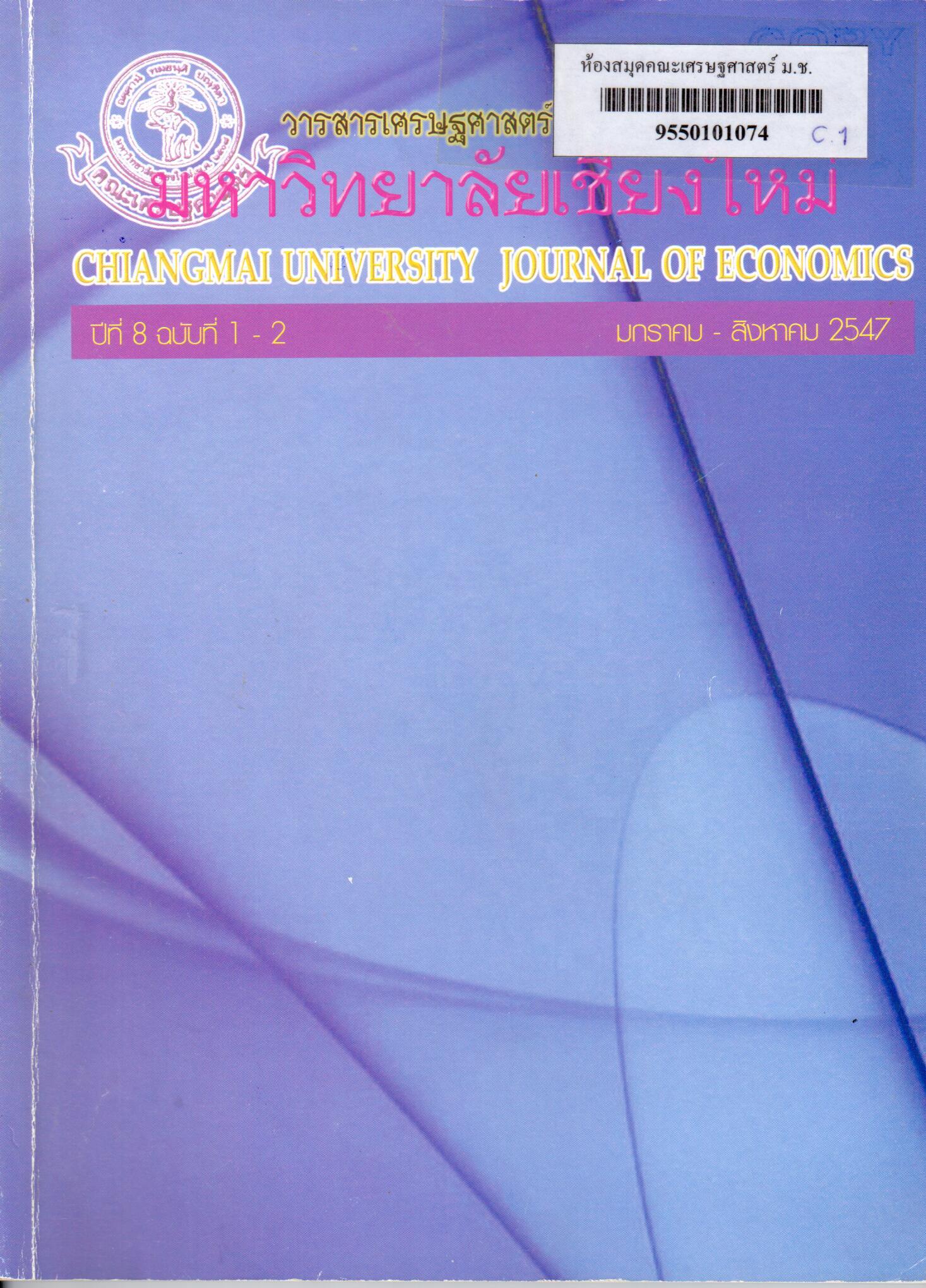การวิเคราะห์เชิงประจักษ์เกี่ยวกับพฤติกรรมและการประเมินผลการดำเนินงานของอุตสาหกรรมลำไยอบแห้งในจังหวัดลำพูน และเชียงใหม่โดยใช้ บาลานซ์ สคอร์การ์ด
Abstract
บทคัดย่อ
บาลานซ์ สคอร์การ์ด เป็นระบบการจัดการที่ไม่เป็นเพียงเครื่องมือที่ใช้วัดการดำเนินงานเท่านั้นแต่ยังเป็นระบบการแปลงวิสัยทัศน์และกลยุทธ์ขององค์กรให้สามารถนำไปใช้ในการดำเนินงานขององค์กร เพื่อให้ตอบสนองต่อเป้าหมายของการบริหารองค์กรใน 4 ด้าน ได้แก่ด้านการเงิน ด้านลูกค้า ด้านกระบวนการภายในธุรกิจ และด้านการเรียนรู้และการเติบโตขององค์กร
การประเมินผลการดำเนินงานของผู้ประกอบการอุตสาหกรรมลำไยอบแห้งโดยใช้บาลานซ์ สคอร์การ์ด พบว่า ในภาพรวมตัวชี้วัดที่ผู้ประกอบการขาดการให้ความสำคัญและละเลยในการนำไปใช้วางแผนการดำเนินงาน ซึ่งไม่สามารถจัดเรียงอยู่ในลำดับ BSC ตั้งแต่ 1 – 10 ลำดับได้เพราะมีเปอร์เซ็นต์การให้ความสำคัญและการนำไปใช้น้อย ได้แก่ตัวชี้วัดดังต่อไปนี้ ตัวชี้วัดด้านจำนวนลูกค้าประจำซึ่งมีเปอร์เซ็นต์ของการให้ความสำคัญและนำไปใช้ คือ 45.27 % และ 43.23 % ตัวชี้วัดด้านระดับระดับความพึ่งพอใจของลูกค้า คือ 45.27 % และ 41.93 % ตัวชี้วัดด้านสภาพแวดล้อมในการทำงาน คือ 43.23 % และ 39.15 % ตัวชี้วัดด้านประสิทธิภาพในการผลิตของพนักงาน คือ 47.87 % และ 40.82 % เทคโนโลยีการผลิต คือ 43.97 % และ 37.29 % และทักษะของพนักงาน คือ 43.97 % และ 38.22 % หากเพิ่มความสำคัญและนำไปใช้ตัวชี้วัดเหล่านี้ จะช่วยให้ได้รับกำไรสูงสุด และเมื่อวิเคราะห์ในแต่ละมิติ (มิติทางด้านพื้นที่ มิติทางด้านลักษณะเตาอบ และมิติทางด้านขนาดของธุรกิจ) พบว่าจะขาดการให้ความสำคัญและละเลยการนำตัวชี้วัดไปใช้ในการวางแผนการดำเนินงานคล้ายคลึงกัน
ในการวิเคราะห์ลักษณะความสัมพันธ์ของมุมมองทางด้านการเงิน และไม่ใช่การเงิน โดยใช้การวิเคราะห์แบบ Multiple Regression พบว่า มุมมองทางด้านการเงินมีความสัมพันธ์ในทิศทางเดียวกันกับด้านลูกค้า ด้านการเรียนรู้และการเจริญเติบโต และมีความสัมพันธ์ในทิศทางตรงกันข้ามกับด้านกระบวนการธุรกิจภายใน และด้านชุมชนและสังคม
ข้อเสนอแนะต่อผู้ประกอบการเพื่อให้การบริหารงานขององค์กรมีความสมดุลกันทั้ง 5 ด้าน ควรเพิ่มความสำคัญและนำตัวชี้วัดในมุมมองทางด้านลูกค้า และทางด้านกระบวนการธุรกิจภายในให้มากขึ้น สำหรับผู้ประกอบการที่ต้องการให้รายได้ขององค์กรเพิ่มขึ้น ประสิทธิภาพการผลิตเพิ่มขึ้น และมีอัตราผลตอบแทนของสินทรัพย์เพิ่มขึ้น ควรจะลดต้นทุนในการผลิต และปรับปรุงระยะเวลาที่ใช้ในการผลิตให้น้อยลง
Abstract
The balance scorecard is a management system (not only a measurement system) that enables organizations to clarify their vision and strategy and translate them into action for response to the organization targets in 4 perspectives – financial perspective, customers perspective, Internal – business – process perspective and growth and learning perspective.
The performance evaluation of dried longan industry practitioners by using Balance Scorecard shows the overall performance of the practitioners were overlooked for using in planning for performance shows the indicators that practitioners overlooked for using in planning for performance which cannot arrange in the 1-10 of the BSC ordering because its less percentages of importance and used to practices that the indicators the number of permanent customer is 45.27 % and 43.23 %, customer satisfaction levels is 45.27 % and 41.93 %, market share is 43.97 % and 41.93 %, working environment is 43.23 % and 39.15 %, technology in production is 43.97 % and 37.29 % and workers’ skill is 43.97 % and 38.22 %. These indicators were actually the main keys to the organization’s profit growth in case if the practitioners give more importance and use them more practically, they could create most profits to practitioners. When analyze into 3 dimensions (the areas for the business, the type of the ovens used and business size), the practitioners employed the indicators to plan for the performance in similarly level of importance and use.
The analysis of the relationship between financial and non-financial performance by using multiple regression methods shows the positive relationship between financial and customer perspective. Another finding reveals the negative relationship between the perspectives of learning and growth, the internal-business-process, and community and society.
The suggestion for help the practitioners to manage perspective balance in theirs business that they should give more importance and use the indicators of customer perspective and learning and growth perspective more practically. For the practitioners who need more returns, capacity of productivity and return on assets is that they should reduce some production cost and manage less time consumed in production.
Downloads
Issue
Section
License
All opinions and contents in the CMJE are the responsibility of the author(s). Chiang Mai University Journal of Economics reserves the copyright for all published materials. Papers may not be reproduced in any form without the written permission from Chiang Mai University Journal of Economics.
ข้อคิดเห็นที่ปรากฏและแสดงในเนื้อหาบทความต่างๆในวารสารเศรษฐศาสตร์มหาวิทยาลัยเชียงใหม่ ถือเป็นความเห็นและความรับผิดชอบโดยตรงของผู้เขียนบทความนั้นๆ มิใช่เป็นความเห็นและความรับผิดชอบใดๆของวารสารเศรษฐศาสตร์ มหาวิทยาลัยเชียงใหม่
บทความ เนื้อหา และข้อมูล ฯลฯ ในวารสารเศรษฐศาสตร์มหาวิทยาลัยเชียงใหม่ ถือเป็นลิขสิทธิ์เฉพาะของคณะเศรษฐศาสตร์มหาวิทยาลัยเชียงใหม่ หากบุคคลหรือหน่วยงานใดต้องการนำทั้งหมดหรือส่วนหนึ่งส่วนใดไปเผยแพร่ต่อหรือเพื่อกระทำการใดๆ จะต้องได้รับอนุญาตเป็นลายลักษณ์อักษร จากวารสารเศรษฐศาสตร์ มหาวิทยาลัยเชียงใหม่






